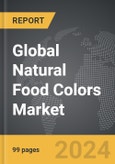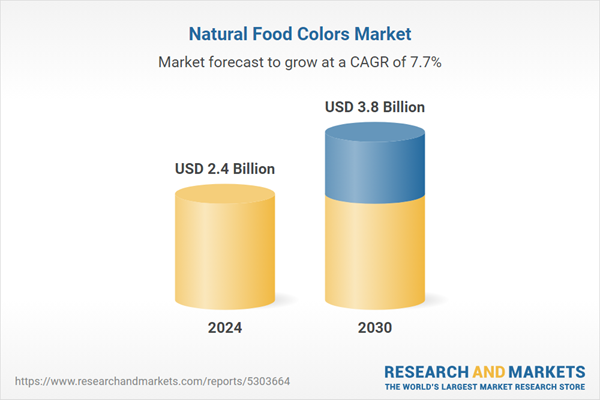The global market for Natural Food Colors was valued at US$2.4 Billion in 2024 and is projected to reach US$3.8 Billion by 2030, growing at a CAGR of 7.7% from 2024 to 2030. This comprehensive report provides an in-depth analysis of market trends, drivers, and forecasts, helping you make informed business decisions. The report includes the most recent global tariff developments and how they impact the Natural Food Colors market.
Segments: Product Type (Carotenoids, Curcumin, Anthocyanin, Carmine, Copper Chlorophyllin, Other Product Types); Application (Beverages, Food, Bakery & Confectionery, Dairy & Frozen Products, Meat Products, Oil & Fat, Other Applications).
Geographic Regions/Countries: World; United States; Canada; Japan; China; Europe (France; Germany; Italy; United Kingdom; Spain; Russia; and Rest of Europe); Asia-Pacific (Australia; India; South Korea; and Rest of Asia-Pacific); Latin America (Argentina; Brazil; Mexico; and Rest of Latin America); Middle East (Iran; Israel; Saudi Arabia; United Arab Emirates; and Rest of Middle East); and Africa.
The analysts continuously track trade developments worldwide, drawing insights from leading global economists and over 200 industry and policy institutions, including think tanks, trade organizations, and national economic advisory bodies. This intelligence is integrated into forecasting models to provide timely, data-driven analysis of emerging risks and opportunities.
Global Natural Food Colors Market - Key Trends and Drivers Summarized
How Are Natural Food Colors Gaining Popularity in the Food and Beverage Industry?
Natural food colors, derived from plant, animal, or mineral sources, are increasingly replacing synthetic food dyes in the food and beverage industry. These colors not only enhance the visual appeal of products but also align with the growing consumer preference for clean-label and natural ingredients. From beverages and confectionery to dairy and bakery products, natural food colors are finding extensive applications across various segments. The increasing awareness of health risks associated with synthetic additives is pushing manufacturers to reformulate products using natural colorants, thereby reshaping the industry landscape.What Are the Emerging Trends in Natural Food Colors?
Several trends are shaping the natural food colors market, including the rising popularity of organic and non-GMO products. As consumers demand transparency about ingredient sourcing, manufacturers are increasingly focusing on certifications such as organic, kosher, and halal. There is also a trend towards using superfood ingredients, such as turmeric, spirulina, and beetroot, as natural colorants, providing both visual appeal and potential health benefits. Technological advancements in extraction and stabilization techniques are making it easier for companies to use natural colors in a wider variety of products, even those with challenging processing conditions like high heat and acidity.Which Segments Are Driving the Market for Natural Food Colors?
Carmine, anthocyanins, and curcumin are among the most commonly used colorants. In terms of applications, beverages represent the largest segment, driven by the increasing use of natural colors in soft drinks, juices, and flavored water. The confectionery and bakery sectors are also significant markets, as manufacturers seek to offer cleaner, more natural ingredient profiles in candies, cakes, and other sweets. The market is experiencing growth across all regions, but Europe and North America lead in adoption due to stringent regulations on synthetic additives.What Factors Are Driving the Growth in the Natural Food Colors Market?
The growth in the natural food colors market is driven by several factors, including increasing consumer preference for clean-label products and the rising demand for natural and organic ingredients. The growing awareness of the potential health risks posed by synthetic food dyes is leading to a shift towards natural alternatives. Additionally, regulatory pressures, particularly in regions like Europe, where strict regulations on artificial additives are enforced, are accelerating the adoption of natural food colors. The expansion of the food and beverage industry, especially in emerging markets, is also contributing to the growth as companies reformulate products to meet the changing consumer preferences.Report Scope
The report analyzes the Natural Food Colors market, presented in terms of units. The analysis covers the key segments and geographic regions outlined below.Segments: Product Type (Carotenoids, Curcumin, Anthocyanin, Carmine, Copper Chlorophyllin, Other Product Types); Application (Beverages, Food, Bakery & Confectionery, Dairy & Frozen Products, Meat Products, Oil & Fat, Other Applications).
Geographic Regions/Countries: World; United States; Canada; Japan; China; Europe (France; Germany; Italy; United Kingdom; Spain; Russia; and Rest of Europe); Asia-Pacific (Australia; India; South Korea; and Rest of Asia-Pacific); Latin America (Argentina; Brazil; Mexico; and Rest of Latin America); Middle East (Iran; Israel; Saudi Arabia; United Arab Emirates; and Rest of Middle East); and Africa.
Key Insights:
- Market Growth: Understand the significant growth trajectory of the Carotenoids segment, which is expected to reach US$1.4 Billion by 2030 with a CAGR of a 8.9%. The Curcumin segment is also set to grow at 7.0% CAGR over the analysis period.
- Regional Analysis: Gain insights into the U.S. market, valued at $627.3 Million in 2024, and China, forecasted to grow at an impressive 11.7% CAGR to reach $950.6 Million by 2030. Discover growth trends in other key regions, including Japan, Canada, Germany, and the Asia-Pacific.
Why You Should Buy This Report:
- Detailed Market Analysis: Access a thorough analysis of the Global Natural Food Colors Market, covering all major geographic regions and market segments.
- Competitive Insights: Get an overview of the competitive landscape, including the market presence of major players across different geographies.
- Future Trends and Drivers: Understand the key trends and drivers shaping the future of the Global Natural Food Colors Market.
- Actionable Insights: Benefit from actionable insights that can help you identify new revenue opportunities and make strategic business decisions.
Key Questions Answered:
- How is the Global Natural Food Colors Market expected to evolve by 2030?
- What are the main drivers and restraints affecting the market?
- Which market segments will grow the most over the forecast period?
- How will market shares for different regions and segments change by 2030?
- Who are the leading players in the market, and what are their prospects?
Report Features:
- Comprehensive Market Data: Independent analysis of annual sales and market forecasts in US$ Million from 2024 to 2030.
- In-Depth Regional Analysis: Detailed insights into key markets, including the U.S., China, Japan, Canada, Europe, Asia-Pacific, Latin America, Middle East, and Africa.
- Company Profiles: Coverage of players such as San-Ei Gen F.F.I., Inc., Archer Daniels Midland Company, Aromata Group S.r.l, BASF SE, Chr. Hansen and more.
- Complimentary Updates: Receive free report updates for one year to keep you informed of the latest market developments.
Some of the 53 companies featured in this Natural Food Colors market report include:
- San-Ei Gen F.F.I., Inc.
- Archer Daniels Midland Company
- Aromata Group S.r.l
- BASF SE
- Chr. Hansen
- D.D. Williamson & Co., Inc.
- Diana Naturals SAS
- Doehler
- FMC Corporation
- GNT Group b.v.
- IFC Solutions
- INCOLTEC
- Kalsec Inc.
- Kolorjet Chemicals Pvt. Ltd.
- Koninklijke DSM N.V.
- Lycored Ltd.
- Naturex S.A.
- Phinix International
- Roha Dye Chem Pvt. Ltd.
- Sensient Technologies Ltd.
- Vinayak Ingredients India Pvt. Ltd.
Tariff Impact Analysis: Key Insights for 2025
Global tariff negotiations across 180+ countries are reshaping supply chains, costs, and competitiveness. This report reflects the latest developments as of April 2025 and incorporates forward-looking insights into the market outlook.The analysts continuously track trade developments worldwide, drawing insights from leading global economists and over 200 industry and policy institutions, including think tanks, trade organizations, and national economic advisory bodies. This intelligence is integrated into forecasting models to provide timely, data-driven analysis of emerging risks and opportunities.
What’s Included in This Edition:
- Tariff-adjusted market forecasts by region and segment
- Analysis of cost and supply chain implications by sourcing and trade exposure
- Strategic insights into geographic shifts
Buyers receive a free July 2025 update with:
- Finalized tariff impacts and new trade agreement effects
- Updated projections reflecting global sourcing and cost shifts
- Expanded country-specific coverage across the industry
Table of Contents
I. METHODOLOGYII. EXECUTIVE SUMMARY2. FOCUS ON SELECT PLAYERSIII. MARKET ANALYSISCANADAITALYSPAINRUSSIAREST OF EUROPESOUTH KOREAREST OF ASIA-PACIFICARGENTINABRAZILMEXICOREST OF LATIN AMERICAIRANISRAELSAUDI ARABIAUNITED ARAB EMIRATESREST OF MIDDLE EASTIV. COMPETITION
1. MARKET OVERVIEW
3. MARKET TRENDS & DRIVERS
4. GLOBAL MARKET PERSPECTIVE
UNITED STATES
JAPAN
CHINA
EUROPE
FRANCE
GERMANY
UNITED KINGDOM
ASIA-PACIFIC
AUSTRALIA
INDIA
LATIN AMERICA
MIDDLE EAST
AFRICA
Companies Mentioned (Partial List)
A selection of companies mentioned in this report includes, but is not limited to:
- San-Ei Gen F.F.I., Inc.
- Archer Daniels Midland Company
- Aromata Group S.r.l
- BASF SE
- Chr. Hansen
- D.D. Williamson & Co., Inc.
- Diana Naturals SAS
- Doehler
- FMC Corporation
- GNT Group b.v.
- IFC Solutions
- INCOLTEC
- Kalsec Inc.
- Kolorjet Chemicals Pvt. Ltd.
- Koninklijke DSM N.V.
- Lycored Ltd.
- Naturex S.A.
- Phinix International
- Roha Dye Chem Pvt. Ltd.
- Sensient Technologies Ltd.
- Vinayak Ingredients India Pvt. Ltd.
Table Information
| Report Attribute | Details |
|---|---|
| No. of Pages | 99 |
| Published | April 2025 |
| Forecast Period | 2024 - 2030 |
| Estimated Market Value ( USD | $ 2.4 Billion |
| Forecasted Market Value ( USD | $ 3.8 Billion |
| Compound Annual Growth Rate | 7.7% |
| Regions Covered | Global |









